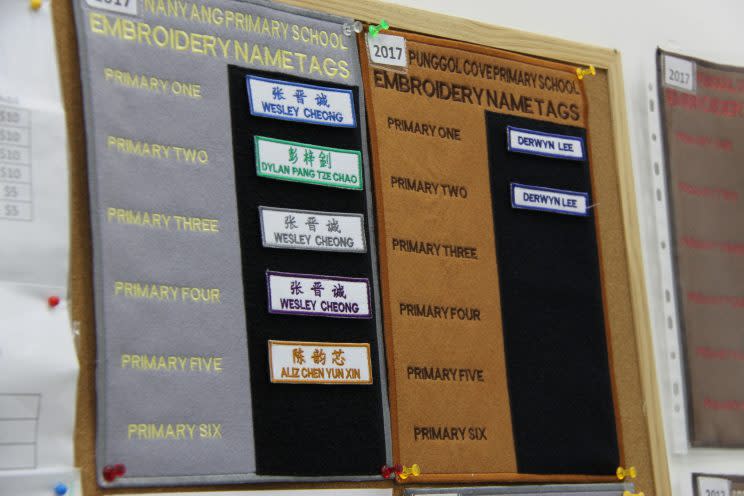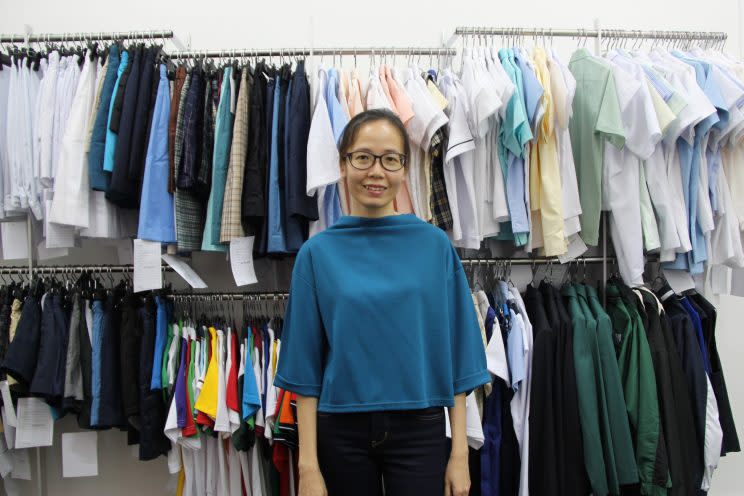Why Singapore’s school uniforms look the way they do

School uniforms are part and parcel of a typical primary and secondary school experience in Singapore. But do you know why school uniforms in the country look the way they do?
From the different colours and fabrics to the various silhouettes of a school uniform, there’s more that goes into these clothes besides making sure they look good in annual class photos and on school posters.
According to the managing director of Shanghai School Uniforms, Doris Yeo Lee Yuen, there are various factors that a school needs to take into consideration when it comes to uniform design. Besides making sure they look appealing and stand out from other school uniforms, other factors such as body sizes, consistency with the school logo and name are taken into account as well.
“We’ll take a look at the school logo and see what are the colours used in the logo. From then on we see how those colours can be used in the uniforms,” said Yeo, who has been working with Shanghai School Uniforms since 2011. Having been around for almost 50 years, the company is known as one of the leading school uniform purveyors in the country.
It was founded by a Mr Chiang in the 1950s before he handed it over to his niece. It was only in 2011 when the company was bought over by a Randhir Bansal. While the niece continues to work for the company, it is Yeo who takes the lead in most of the company’s operations.
“My boss thought it a pity to see a company with such strong heritage to close down. We were able to aid the company financially as well as in technology, after the buy-over,” said Yeo, who previously managed Randhir’s other business units prior to managing Shanghai School Uniforms.
From having little experience in the garment industry to being quite the expert in the manufacturing of school uniforms, the quick-learner continued to share with us more about what goes into the making of a school uniform.

Little room to be fashionable
For many of the newer schools in Singapore, such as the ones in newer neighborhoods, including Punggol and Sengkang, the younger principals and vice-principals of these schools tend to be more fashion-forward and creative in the way they envision their school uniforms.
However, it’s more important to be practical than fashionable when it comes to the design of school uniforms, according to Yeo.
“I’ve had teachers come up to me asking for the skirts to flow naturally instead of having pleats. When they tell me that, I’ll ask them to consider how the skirts might look on the more curvaceous girls. A-line skirts may look flattering on petite girls, but not so much on those on the heavier side,” she said.
Over the years, Yeo observed that sizes of Singapore’s students have had a shift. “It used to be a bell curve in which the M-sized students would take up the bulk of the school uniform sizes. These days, the students are either too small or too big. The graph is flat for the M-sizes,” she said.
Practicality is factored in when it comes to choice of fabrics, as well. “We need to think of the parents who will be caring for these clothes. A lot of time, these students would just throw them into the washing machine, so you need to make sure the fabric can withstand multiple washes and that the colors don’t fade easily,” said Yeo.
Some of the popular fabrics used for school uniforms are cotton, polyester and most recently Dri-FIT fabrics for P.E. (physical education) attire.

How school mergers impact the school uniform business
A number of schools have had to merge in recent years mainly due to insufficient enrollment, with the biggest batch of mergers involving 22 secondary schools, including Siglap Secondary School merging with Coral Secondary School and Bedok North with Damai Secondary School.
When this happens, school uniform purveyors will have to make several adjustments to the school uniform supplies. Yeo explained,” When school A merges with school B, and students have to be relocated to school B, all students will have to wear uniforms of school B until the principal makes a decision to change the school uniforms.”
As a result, Shanghai School Uniforms may have to suffer losses as they have to deal with the excess of uniforms from school A.
“That’s unfortunate, but we don’t have a choice but to terminate contracts with some schools early. In the last year, I’ve started working with some charities to donate the excess school uniforms. One of which is the Kidu Foundation from Bhutan,” she said.
School uniform purveyors are usually notified of changes to school uniforms much later than the announcement of mergers, said Yeo. Deciding on a new principal takes a while too, she added.

Why are school uniforms still important today?
Singapore isn’t the only country in the region where school uniforms are compulsory for students. In countries such as Malaysia and Indonesia, students across different schools wear the same uniform design.
“Singapore was a little bit like that in the past. I think back in the ’60s, [for] a lot of the more Chinese schools, you see that their uniforms are almost the same,” she said.
When asked why it’s important for different schools in Singapore to have different school uniforms, she said, “While all schools in Singapore are good schools, every school still tries to come up with their own marketing niche. Maybe this school excels more in sports, or this school excels more in aesthetics, and this school more in academics. I think in terms of image, they still want that differentiation [in terms school uniforms].”
As some may still argue over the importance – or relevance – of school uniforms in this day, Yeo stays true to her stand, which is that school uniforms are still important as they teach students some form of discipline.
“I think certain elements of discipline in school is still necessary. Somehow, wearing a uniform may help to reinforce that. Otherwise, everything can go out of the place,” said Yeo.
With that said, Yeo added that students “shouldn’t let uniforms restrict you from thinking out of the box”.
Related stories:
Palestinian Fashion Designer Breathes New Life Into Tradition
Summer’s most popular color actually isn’t Millennial pink, it’s this totally standard shade
Follow Yahoo Lifestyle Singapore on Facebook.



